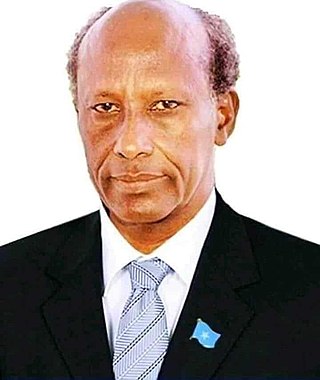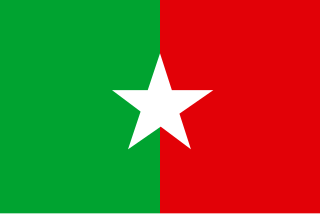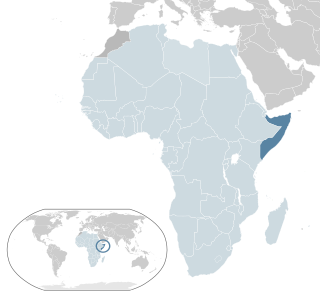
Mohamed Farrah Hassan Garad, known as General Aidid or Aideed was a Somali general and diplomat.

Mohammed Siad Barre was a Somali military officer, politician and revolutionary who served as the head of state of Somalia from 21 October 1969 to 26 January 1991.

The Somali Democratic Republic was the name that the socialist military government gave to Somalia under President Major General Mohamed Siad Barre, after seizing power in a coup d'état on 21 October 1969. The coup came a few days after a bodyguard assassinated Abdirashid Shermarke, the nation's second President. Barre's administration ruled Somalia for the next 21 years until Somalia collapsed into civil war in 1991.

The Western Somali Liberation Front was a separatist rebel group fighting in eastern Ethiopia to liberate the Somali region from Ethiopian control and rejoin Somalia. It played a major role in the Ogaden War of 1977-78 assisting the invading Somali Army.

The Ogaden War, also known as the Ethio-Somali War, was a military conflict fought between Somalia and Ethiopia from July 1977 to March 1978 over the Ethiopian region of Ogaden. Somalia's invasion of the region, precursor to the wider war, met with the Soviet Union's disapproval, leading the superpower to end its support of Somalia and support Ethiopia instead.

Mohammad Ali Samatar. was a very senior Somali National hero, Revolutionary, Military Officer, Communist, Politician, former Commander-in-Chief of the Somali National Army, former Minister of Defence, former Vice President, former Deputy General Secretary of the Somali Revolutionary Socialist Party, former Prime Minister, a leading figure and the second most powerful man in the Somali Democratic Republic after president Mohamed Siad Barre. He's the only officer who has ever reached the rank of Lieutenant General in the history of the Somali Armed Forces. He was known for his intelligent military tactics in the 1964 Ethiopian–Somali Border War, Ogaden War and 1982 Ethiopian–Somali Border War. He's regarded as one of the greatest military officers of the African continent.

Mohamed Abdel Ghani el-Gamasy was an Egyptian Field Marshal (Mushir) and the Commander in Chief of The Armed Forces. He has been called "one of the architects of the Yom Kippur War."
The Somali Rebellion was the beginning of the civil war in Somalia that occurred in the 1980s and early 1990s. The rebellion started in 1978 when President Siad Barre began using his special forces, the "Red Berets", to attack clan-based dissident groups opposed to his regime. The dissidents had been becoming more powerful for nearly a decade following his abrupt switch of allegiance from the Soviet Union to the United States and the disastrous 1977-78 Ogaden War.

The Order of the Nile was established in 1915 and was one of the Kingdom of Egypt's principal orders until the monarchy was abolished in 1953. It was then reconstituted as the Republic of Egypt's highest state honor.

The Most Esteemed Order of the Defender of the Realm is a Malaysian federal award presented for meritorious service to the country. The Order Motto are 'Dipeliharakan Allah-Pangkuan Negara'.
Osman Mahmoud is a Somali sub-clan and is one of the largest sub-clans within the major Majeerteen Harti confederation of Darod. The sub-clan is most renowned for its rich history within Somalia, That of which include sultanates such as the Majeerteen Sultanate and Hobyo Sultanate.
The Safari Club was a covert alliance of intelligence services formed in 1976 that ran clandestine operations around Africa at a time when the United States Congress had limited the power of the CIA after years of abuses and when Portugal was dismantling its colonial empire in Africa. Its formal members were the pre-revolution (Pahlavi) Iran, Egypt, Saudi Arabia, Morocco and France. The group maintained informal connections with the United States, South Africa, Rhodesia and Israel. The group executed a successful military intervention in Zaire in response to an invasion from Angola. It also provided arms to Somalia in its 1977–1978 conflict with Ethiopia. It organized secret diplomacy relating to anti-Communism in Africa, and has been credited with initiating the process resulting in the 1979 Egypt–Israel peace treaty.
The 1982 Ethiopian–Somali Border War occurred between June and August 1982 when Ethiopia, sending a 10,000 man invasion force backed by warplanes and armored units, supported by thousands of SSDF rebels invaded Central Somalia. The United States government responded by speeding up deliveries of light arms and main battle tanks already promised. In addition, the initially pledged US$45 million in economic and military aid was increased to US$80 million.

The Order of King Abdulaziz is a Saudi Arabian order of merit. The order was named after Abdulaziz Al Saud, founder of the modern Saudi state.

The military history of Somalia encompasses the major conventional wars, conflicts and skirmishes involving the historic empires, kingdoms and sultanates in the territory of present-day Somalia, through to modern times. It also covers the martial traditions, military architecture and hardware employed by Somali armies and their opponents.

Abdullahi Ahmed Irro, also known as Abdullahi Ahmad Yousef Irro, was a prominent Somali military professor and general. He helped establish the National Academy for Strategy.

Russia–Somalia relations is the bilateral relationship between Russia and Somalia. A Somali Embassy currently operates in Moscow. Russia's embassy in Djibouti represents Russia in Somalia.

The Isaaq genocide, also known as the Hargeisa holocaust, was the systematic, state-sponsored genocide of Isaaq civilians between 1987 and 1989 by the Somali Democratic Republic, under the dictatorship of Siad Barre, during the Somaliland War of Independence. The number of civilian deaths in this massacre is estimated to be between 50,000 and 100,000, according to various sources, whilst local reports estimate the total civilian deaths to be upwards of 200,000 Isaaq civilians. The genocide also included the levelling and complete destruction of the second and third largest cities in the Somali Republic, Hargeisa and Burao, respectively, and had caused up to 500,000 Somalis of the region, primarily of the Isaaq clan, to flee their land and cross the border to Hartasheikh in Ethiopia as refugees in what was described as "one of the fastest and largest forced movements of people recorded in Africa", which resulted in the creation of the world's largest refugee camp then (1988), with another 400,000 being displaced. The scale of destruction led to Hargeisa being known as the 'Dresden of Africa'. The killings happened during the Somali Civil War and have been referred to as a "forgotten genocide".

The 1978 Somali coup d'état attempt was a violent military coup attempt that took place in Somalia on 9 April 1978, against the regime of President Siad Barre. The United States Central Intelligence Agency estimated that the coup, led by Colonel Mohamed Osman Irro, involved around 24 officers, 2,000 soldiers, and 65 tanks. Following the failed coup, 17 alleged ringleaders, including Osman, were summarily executed by firing squad.

This is a list of the Orders, Medals and Ribbon awards of the Federal Republic of Somalia, of which the honours system consists of orders and medals awarded for exemplary service to the nation.


















